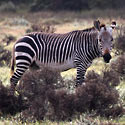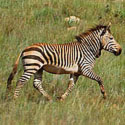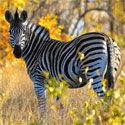|
Family: Equidae (horses, zebras, donkeys)
Life
>
Eukaryotes >
Opisthokonta >
Metazoa (animals) > Bilateria > Deuterostomia >
Chordata > Craniata > Vertebrata (vertebrates) >
Gnathostomata (jawed vertebrates) > Teleostomi (teleost
fish) > Osteichthyes (bony fish) > Class:
Sarcopterygii (lobe-finned fish) > Stegocephalia
(terrestrial vertebrates) > Reptiliomorpha > Amniota >
Synapsida (mammal-like reptiles) > Therapsida > Theriodontia
> Cynodontia > Mammalia (mammals)
> Placentalia (placental mammals) >
Laurasiatheria > Ferungulata > Paraxonia > Perissodactyla (odd-toed
ungulates)
Species indigenous to southern Africa
|
Equus zebra zebra (Cape mountain zebra)
This subspecies of Mountain zebra is currently limited in distribution to a
few national parks and reserves in the Western Cape and Eastern Cape
provinces of South Africa. It very nearly went extinct but was saved through
the creation of the Mountain Zebra National Park. It inhabits mountainous
areas with grass, up to an elevation of about 2000 m. |
 |
|
Equus zebra hartmannae (Hartmann's mountain zebra)
Limited to the montane escarpment of Namibia, and extending marginally into
south-western Angola.It is larger than the Cape mountain zebra, which is the
other subspecies of Mountain zebra. Mountain zebras are best distinguished
from Plains zebra by the fact that the stripes do not extend under the
belly. |
 |
|
Equus quagga (Plains
zebra) The extension of the stripes beneath the belly is
perhaps the easiest way of distinguishing this zebra from the Mountain
zebra. The Plains Zebra inhabits open savannah woodland, open scrub and
grassland with available water and its natural distribution extends from
East Africa down to the northern and eastern areas of southern Africa. It
has also been introduced back into the Cape in a project to selectively
breed a Plain's zebra that looks similar to the extinct Quagga. |
 |
Domesticated species in southern Africa
|
